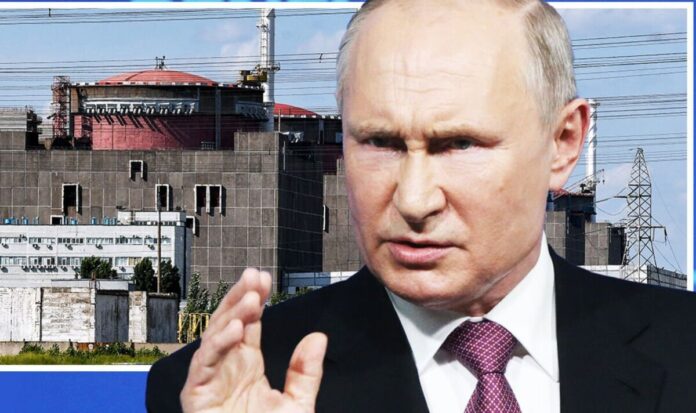It is impossible to predict what will happen at Zaporizhzhia Nuclear Power Plant (ZNPP) 18 months after the facility in southern Ukraine was seized by Russian troops, a nuclear scientist has warned. And Mykola Steinberg, who as Chief Engineer was in charge of managing the Chernobyl Nuclear Power Plant disaster in 1986, believes not even the Russians themselves know what condition ZNPP is currently in. The situation at ZNPP has been the cause of grave concern since Vladimir Putin ‘s invasion on February 24, 2022, not least because it was at the centre of heavy fighting between Russian and Ukrainian forces at the start of the war. Last month Volodymyr Zelensky said Russia had placed ‘objects resembling explosives’ on roofs at the plant, although his claims could not be independently verified, with the Ukrainian President suggesting the Kremlin was planning to sabotage the facility. Earlier this week, Ukrainian state-run company Energoatom said power unit Number had been put into a ‘hot shutdown’ state as of July 24, describing such a move as ‘a gross violation of the licence requirements to operate the nuclear facility’. Vladimir Putin’s Russia seized ZNPP last year (Image: GETTY) Mr Steinberg, who ran Chernobyl from May 1986, days after the disaster, to March 1987, told Express.co.uk: ‘The Zaporizhzhia Nuclear Power Plant has been under the control of aggressor forces for over a year. ‘There are no restrictions on the presence of occupying units on the station’s premises. ‘There are also no limitations on sabotage activities. According to the laws of Ukraine and international conventions, “de facto” since March 4, 2022, the Zaporizhzhia Nuclear Power Plant has been in a state of permanent terrorist threat.’ As a nuclear facility, the Zaporizhzhia Nuclear Power Plant, and all its complex equipment, systems, and supporting personnel, had been operating outside the framework of laws and regulatory documents since March 4, 2022, when it was captured by Russian troops, Mr Steinberg pointed out. Volodymyr Zelensky, Ukraine’s President (Image: Getty) He continued: ‘Some things are being adhered to, others are being violated, and some have been completely disregarded because they were deemed obstructive. ‘The main issue at the station is the absence of an established and verified team that has undergone the required scrutiny according to Ukrainian laws. ‘In simpler terms, it’s like a plane that took off from point A to point B, and during the flight, the crew was replaced. They picked a few people from the passengers who had read some books about airplanes somewhere, and then said, ‘Now, you fly!’ ‘I believe that predicting the final outcome today is beyond anyone’s capability.’ The town of Pripyat remains abandoned almost 40 years after the Chernobyl disaster (Image: Getty) Mr Steinberg was also highly dubious about the ability of the International Atomic Energy Association (IAEA), the world’s nuclear power watchdog, the monitor the situation adequately. He explained: ‘Naturally, the Russians are not providing full information. I believe that the Russians themselves might not know the actual state of the station. ‘An NPP (Nuclear Power Plant) is not the kind of facility you can fully understand in just a few months, even if you have experience working at a similar site. It takes years of experience to confidently say, ‘I know my station’. Unfortunately, the UN-affiliated IAEA ‘has very limited powers to influence violators of conventions, nuclear safety standards, etc’, Mr Steinberg argued. He explained: ‘Even its limited measures can only be applied through the UN Security Council, and the world is well aware of the Council’s limitations, especially when the violator is a state with a ‘veto’ right in the Security Council.’ Zaporizhzhia Nuclear Power Plant (Image: Getty) Mr Steinberg nevertheless downplayed comparisons between the Soviet-era Chernobyl meltdown, which is still the world’s worst nuclear disaster, and the situation at ZNPP. He said: ‘Comparing these two power plants can only be done conditionally. They are entirely different projects with distinct characteristics and safety systems. ‘The Chernobyl accident occurred in an operational reactor, where the source of the accident was the reactor itself, containing a vast amount of radioactive materials, including iodine. ‘The Zaporizhzhia reactors have been shut down for over 10 months, and no new radioactive products are being generated. There is no iodine. ‘It is currently impossible to repeat the Chernobyl accident scenario at the Zaporizhzhia Nuclear Power Plant.’
Ukraine nuclear plant endgame ‘impossible to predict’ warns ex-Chernobyl chief
Sourceexpress.co.uk
RELATED ARTICLES


